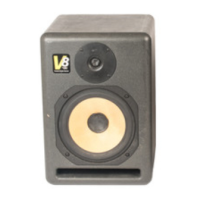
Do you have a question about the KRK V8 and is the answer not in the manual?
| Amplifier Class | Class D |
|---|---|
| Drivers | 8" Woofer, 1" Tweeter |
| Max SPL | 118 dB |
| Power Output | 230W |
| Input Impedance | 10 kΩ Balanced |
| Input Connectors | XLR, TRS |
Details key features of the V8 Studio Monitor, including connectors and controls.
Adjusts input sensitivity from -30dB to +6dB.
3-position toggle switch for +1dB, Flat, or -1dB shelving above 1 kHz.
3-position toggle switch for low frequency turnover at 45Hz, 50Hz, or 65Hz.
Instructions for turning the monitor on/off and the LED indicator status.
Procedure to change operating voltage and replace fuses for different voltage settings.
Wiring information for balanced and unbalanced signals using the combo connector.
Advice on monitor placement for imaging capability and sound adjustment.
Describes close-field configurations using an equilateral triangle setup.
Describes a mid-field setup for larger monitors or better spatial imaging.
Guidance on subwoofer placement, phase setting, and output level adjustment.
Instructions for setting up a 5.1 surround sound system with monitors.
Explains KRK's design philosophy for the V8 monitor for clarity and accuracy.
Monitors translate mixes accurately to other environments.
Active input circuit accepts balanced or unbalanced signals.
Three filters provide superior linear frequency response.
Durable amplifier construction with toroidal transformer.
No signal compression to maintain dynamic range.
Cabinet construction details including MDF and finish.
Features custom-designed Kevlar LF drivers for optimal performance.
Troubleshooting steps for power issues, including fuse and voltage checks.
Troubleshooting steps for no audio output, checking connections and controls.
Troubleshooting steps for sudden operational failure, including overheating.
Troubleshooting steps for altered sound quality, checking drivers and electronics.
Troubleshooting steps for noise issues, checking connections and power.
Details on driver size, frequency response, cabinet, and dimensions.
Specifications for power rating, signal-to-noise, THD, and input impedance.
Details on crossover frequency, slope, and subsonic filter.
Lists key features like connectors, gain control, and LED indicators.
Explains safety symbols and general precautions for equipment use.
Cautions about electrical shock, user-serviceable parts, and servicing.
Warnings about power sources, grounding, and referring servicing to qualified personnel.